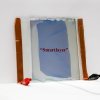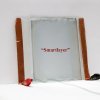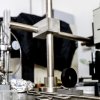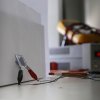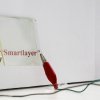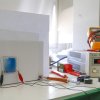The dielectric constant of PZT can range from 300 to 3850, depending upon orientation and doping.
Being pyroelectric, this material develops a voltage difference across two of its faces under changing temperature conditions; consequently, PZT can be used as a heat sensor. PZT is also ferroelectric, which means it has a spontaneous electric polarization (electric dipole) that can be reversed in the presence of an electric field.
The material features an extremely large dielectric constant at the morphotropic phase boundary (MPB) near x = 0.52. Some formulations are ohmic until at least 250 kV/cm (25 MV/m), after which current grows exponentially with field strength before reaching avalanche breakdown; but PZT exhibits time-dependent dielectric breakdown — breakdown may occur under constant-voltage stress after minutes to hours, depending on voltage and temperature, so its dielectric strength depends on the time scale over which it is measured.[3] Other formulations have dielectric strengths measured in the 8–16 MV/m range.[4]
PZT ultrasound transducer
PZT-based materials are components of ultrasound transducers and ceramic capacitors, STM/AFM actuators (tubes).
PZT is used to make ultrasound transducers and other sensors and actuators, as well as high-value ceramic capacitors and FRAM chips. PZT is also used in the manufacture of ceramic resonators for reference timing in electronic circuitry. In 1975 Sandia National Laboratories created anti-flash goggles featuring PZLT to protect aircrew from burns and blindness in case of a nuclear explosion.[5] The PLZT lenses could turn opaque in less than 150 microseconds












